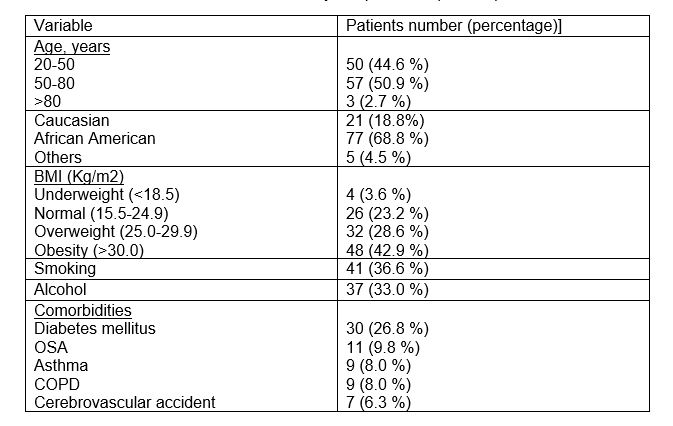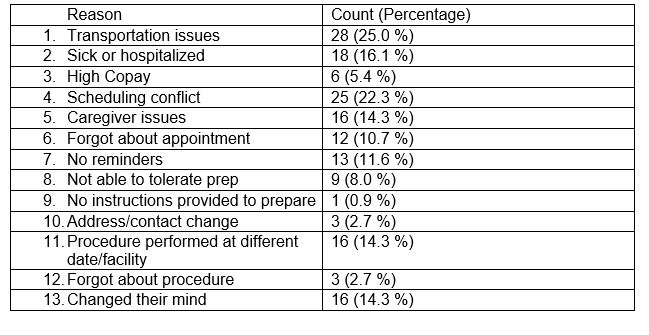Tuesday Poster Session
Category: General Endoscopy
P5116 - Understanding No-Show Endoscopic Appointments: Patient Characteristics and Barriers
Tuesday, October 28, 2025
10:30 AM - 4:00 PM PDT
Location: Exhibit Hall

Karan Sachdeva, MD (he/him/his)
Louisiana State University Health
Shreveport, LA
Presenting Author(s)
Karan Sachdeva, MD1, Cole Bourgeois, BS2, Dylan Thompson, BS2, Rohit Goyal, MD3, Shruti Jain, MBBS1, Khadija Khan, MD2, David Okuampa, MD2, Lovekirat Dhaliwal, MD4, Sudha Pandit, MD3
1Louisiana State University Health, Shreveport, LA; 2LSU Health Shreveport, Shreveport, LA; 3Louisiana State University, Shreveport, LA; 4Emory University Hospital, Atlanta, GA
Introduction: Missed appointments, or "no-shows," result in delayed access to potentially life-saving procedures. This issue is especially critical in gastroenterology, where a growing shortage of specialists contributes to long wait times for procedures such as colonoscopic screening. A significant portion of these appointments are eventually rescheduled, further burdening an already strained scheduling system. In some cases, patients are lost to follow-up and never receive necessary procedures. Our aim was to identify patient characteristics and reasons for missed endoscopy appointments to inform strategies that reduce no-shows and improve care access.
Methods: We conducted a retrospective descriptive study at a tertiary care hospital. Patients were referred for endoscopic procedures by their physicians, either from outpatient clinics or during inpatient admissions. Appointments were scheduled and confirmed by endoscopy unit staff, with procedure-specific instructions provided. We reviewed charts from July 2024 to December 2024 to identify patients who failed to attend their scheduled endoscopy appointments. Baseline sociodemographic data were collected, and patients were contacted via phone using a standardized questionnaire to determine reasons for non-attendance. Institutional Review Board (IRB) approval was obtained.
Results: A total of 552 patients were identified as no-shows during the study period. Of these, 112 patients (20.3%) were successfully contacted and completed the survey. The mean age was 51.3 years, and 40 (36%) were male. Majority were African American (68.8%), and 42.9% had obesity (BMI ≥ 30). Smoking (36.6%) and alcohol use (33%) were also common. Top reasons for missed appointments included transportation barriers (25%), scheduling conflicts (22.3%), and acute illness or hospitalization (16.1%).
Discussion: Improving patient education about the consequences of missed appointments and enhancing communication strategies may reduce no-show rates. Future directions include analyzing the relationship between social deprivation index and missed appointments to design targeted interventions.

Figure: Table 1. Baseline characteristics of survey respondents (n = 112)

Figure: Table 2. Reasons for missed appointments (n = 112)
Disclosures:
Karan Sachdeva indicated no relevant financial relationships.
Cole Bourgeois indicated no relevant financial relationships.
Dylan Thompson indicated no relevant financial relationships.
Rohit Goyal indicated no relevant financial relationships.
Shruti Jain indicated no relevant financial relationships.
Khadija Khan indicated no relevant financial relationships.
David Okuampa indicated no relevant financial relationships.
Lovekirat Dhaliwal indicated no relevant financial relationships.
Sudha Pandit: Medtronic – Product feedback.
Karan Sachdeva, MD1, Cole Bourgeois, BS2, Dylan Thompson, BS2, Rohit Goyal, MD3, Shruti Jain, MBBS1, Khadija Khan, MD2, David Okuampa, MD2, Lovekirat Dhaliwal, MD4, Sudha Pandit, MD3. P5116 - Understanding No-Show Endoscopic Appointments: Patient Characteristics and Barriers, ACG 2025 Annual Scientific Meeting Abstracts. Phoenix, AZ: American College of Gastroenterology.
1Louisiana State University Health, Shreveport, LA; 2LSU Health Shreveport, Shreveport, LA; 3Louisiana State University, Shreveport, LA; 4Emory University Hospital, Atlanta, GA
Introduction: Missed appointments, or "no-shows," result in delayed access to potentially life-saving procedures. This issue is especially critical in gastroenterology, where a growing shortage of specialists contributes to long wait times for procedures such as colonoscopic screening. A significant portion of these appointments are eventually rescheduled, further burdening an already strained scheduling system. In some cases, patients are lost to follow-up and never receive necessary procedures. Our aim was to identify patient characteristics and reasons for missed endoscopy appointments to inform strategies that reduce no-shows and improve care access.
Methods: We conducted a retrospective descriptive study at a tertiary care hospital. Patients were referred for endoscopic procedures by their physicians, either from outpatient clinics or during inpatient admissions. Appointments were scheduled and confirmed by endoscopy unit staff, with procedure-specific instructions provided. We reviewed charts from July 2024 to December 2024 to identify patients who failed to attend their scheduled endoscopy appointments. Baseline sociodemographic data were collected, and patients were contacted via phone using a standardized questionnaire to determine reasons for non-attendance. Institutional Review Board (IRB) approval was obtained.
Results: A total of 552 patients were identified as no-shows during the study period. Of these, 112 patients (20.3%) were successfully contacted and completed the survey. The mean age was 51.3 years, and 40 (36%) were male. Majority were African American (68.8%), and 42.9% had obesity (BMI ≥ 30). Smoking (36.6%) and alcohol use (33%) were also common. Top reasons for missed appointments included transportation barriers (25%), scheduling conflicts (22.3%), and acute illness or hospitalization (16.1%).
Discussion: Improving patient education about the consequences of missed appointments and enhancing communication strategies may reduce no-show rates. Future directions include analyzing the relationship between social deprivation index and missed appointments to design targeted interventions.

Figure: Table 1. Baseline characteristics of survey respondents (n = 112)

Figure: Table 2. Reasons for missed appointments (n = 112)
Disclosures:
Karan Sachdeva indicated no relevant financial relationships.
Cole Bourgeois indicated no relevant financial relationships.
Dylan Thompson indicated no relevant financial relationships.
Rohit Goyal indicated no relevant financial relationships.
Shruti Jain indicated no relevant financial relationships.
Khadija Khan indicated no relevant financial relationships.
David Okuampa indicated no relevant financial relationships.
Lovekirat Dhaliwal indicated no relevant financial relationships.
Sudha Pandit: Medtronic – Product feedback.
Karan Sachdeva, MD1, Cole Bourgeois, BS2, Dylan Thompson, BS2, Rohit Goyal, MD3, Shruti Jain, MBBS1, Khadija Khan, MD2, David Okuampa, MD2, Lovekirat Dhaliwal, MD4, Sudha Pandit, MD3. P5116 - Understanding No-Show Endoscopic Appointments: Patient Characteristics and Barriers, ACG 2025 Annual Scientific Meeting Abstracts. Phoenix, AZ: American College of Gastroenterology.
